

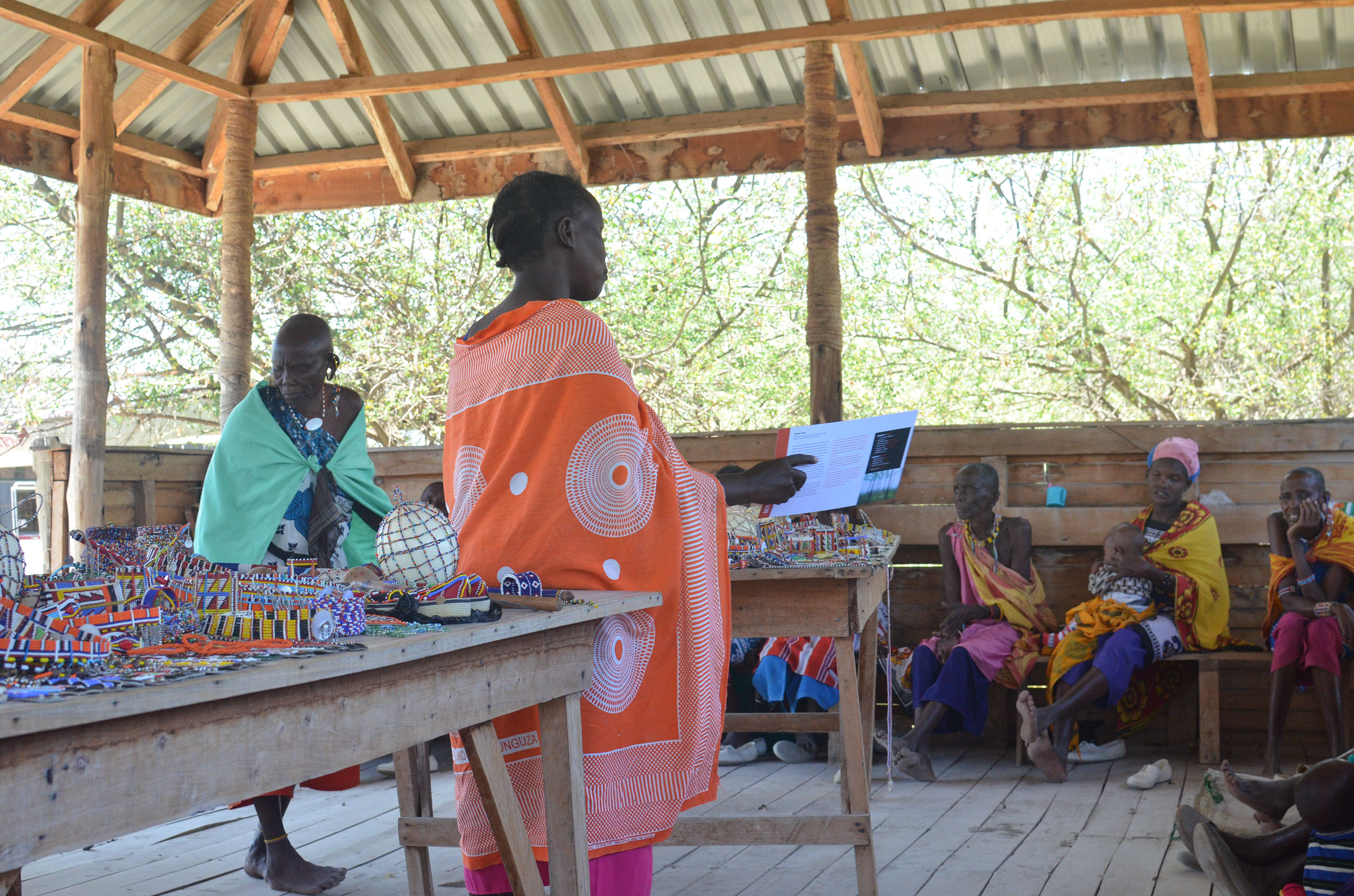
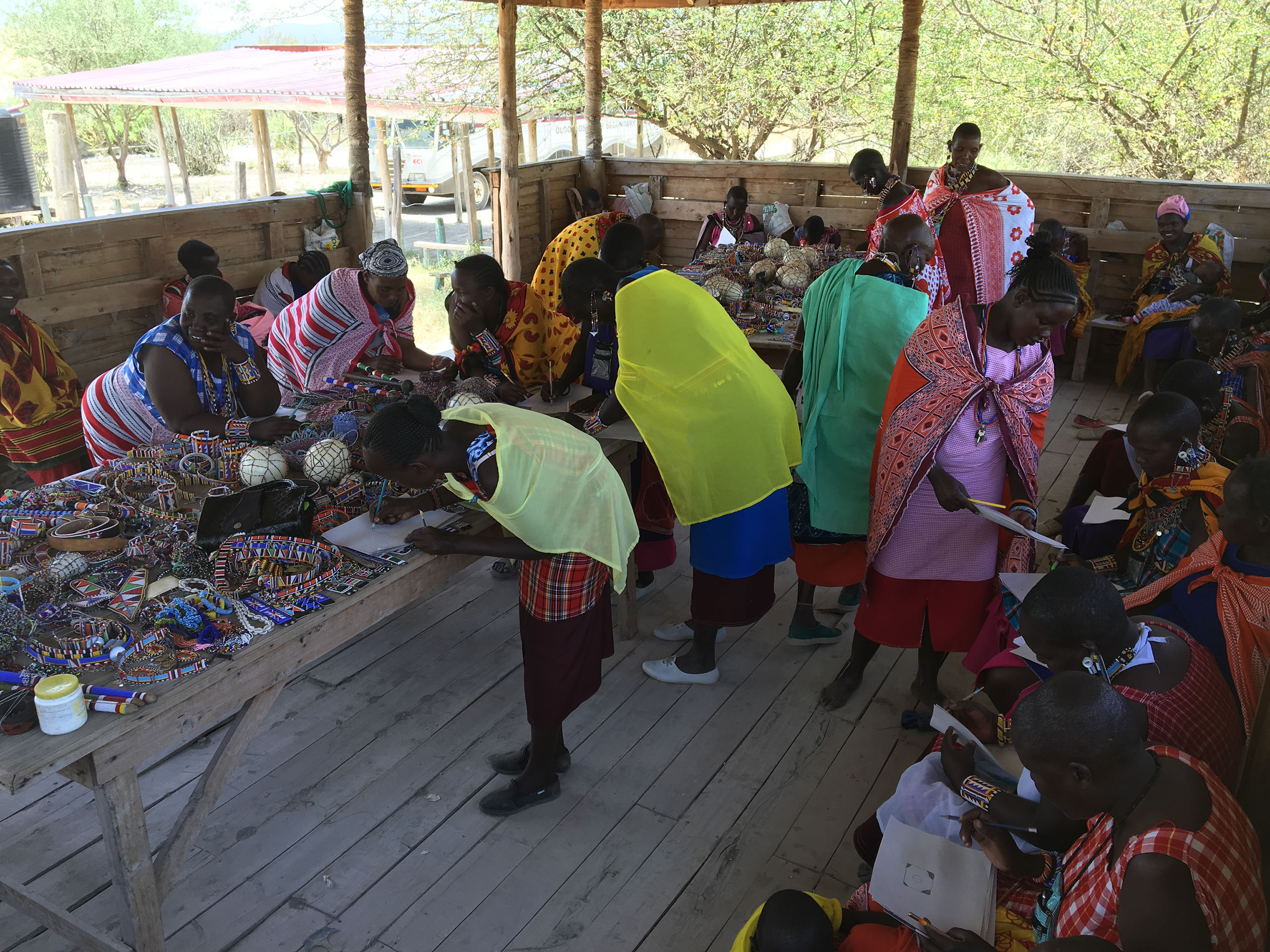
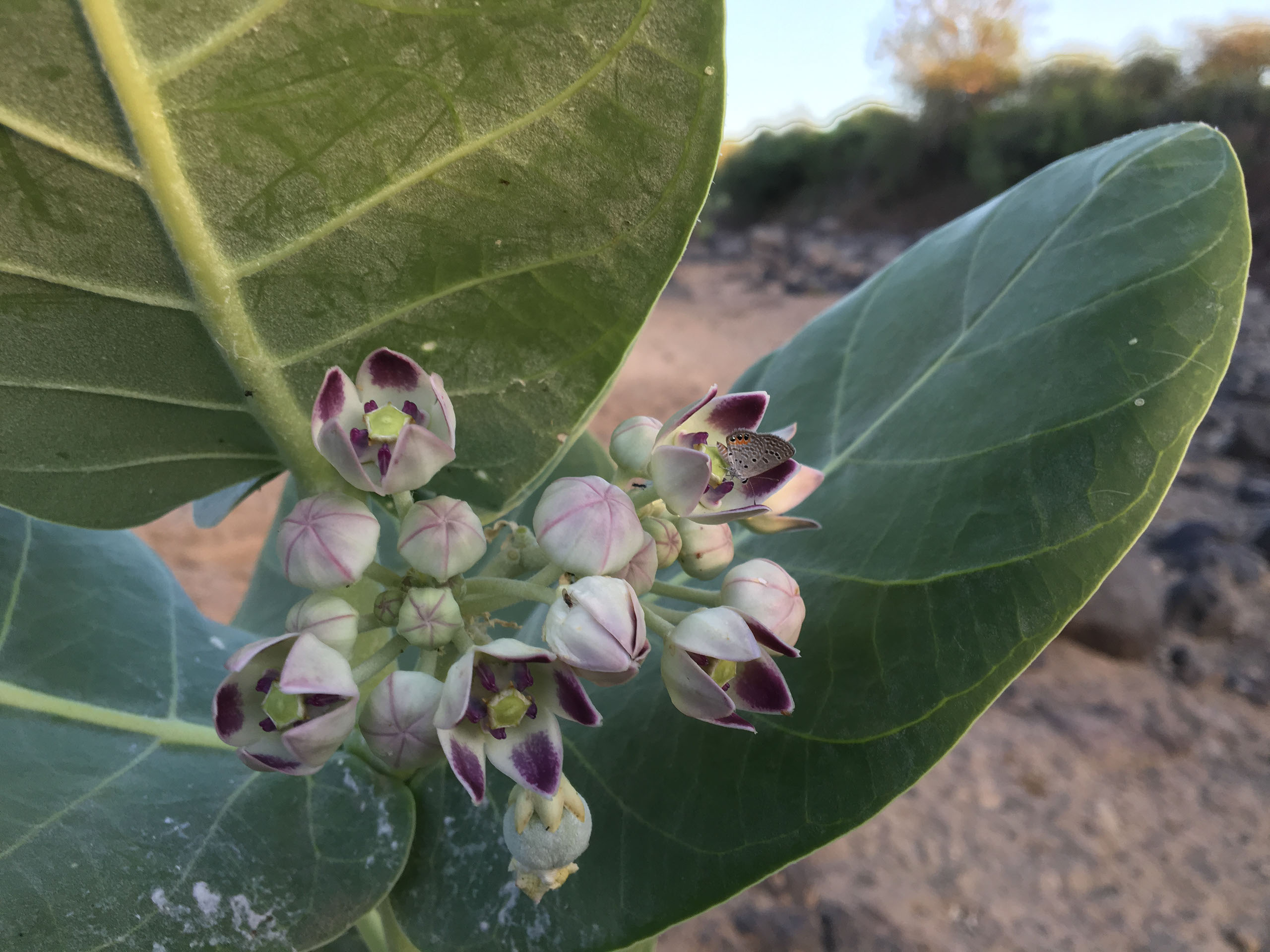

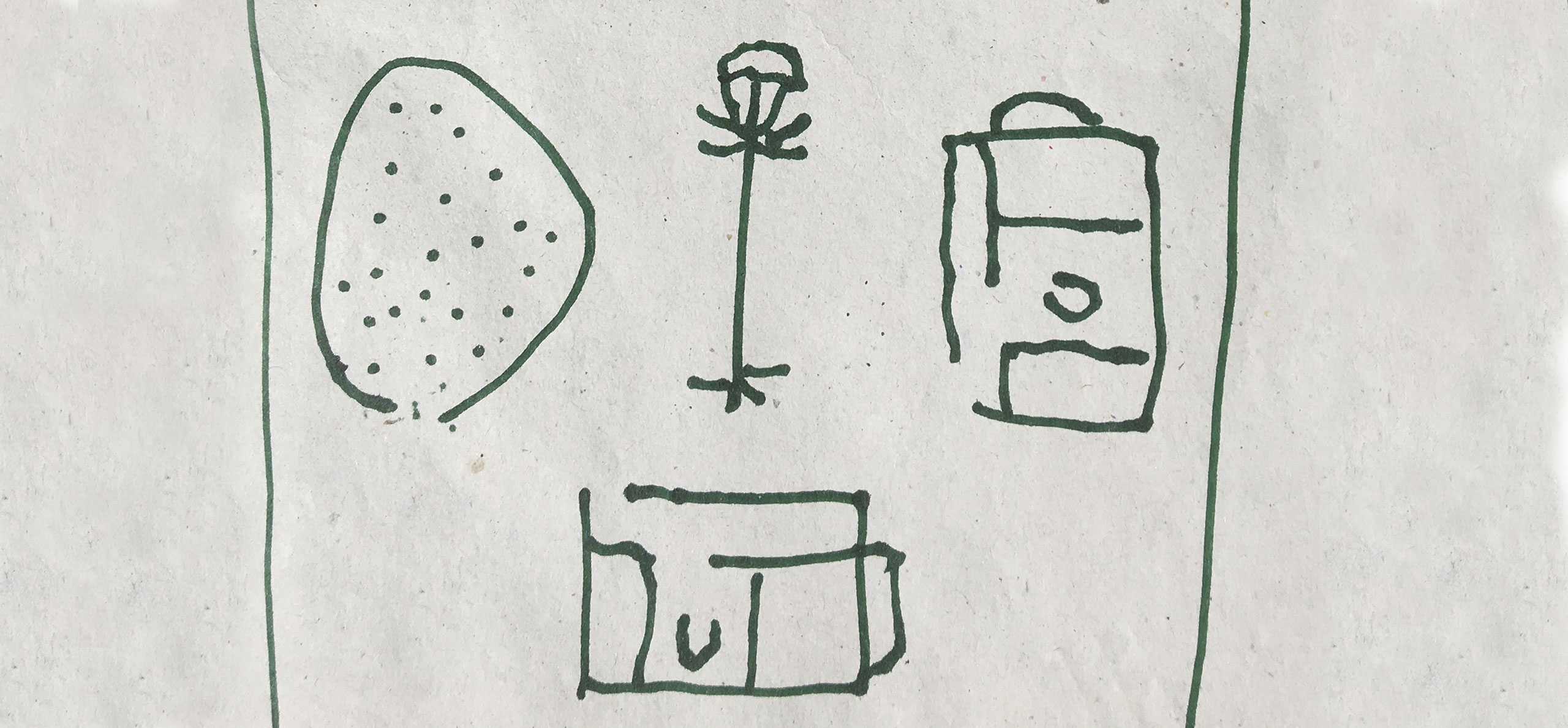
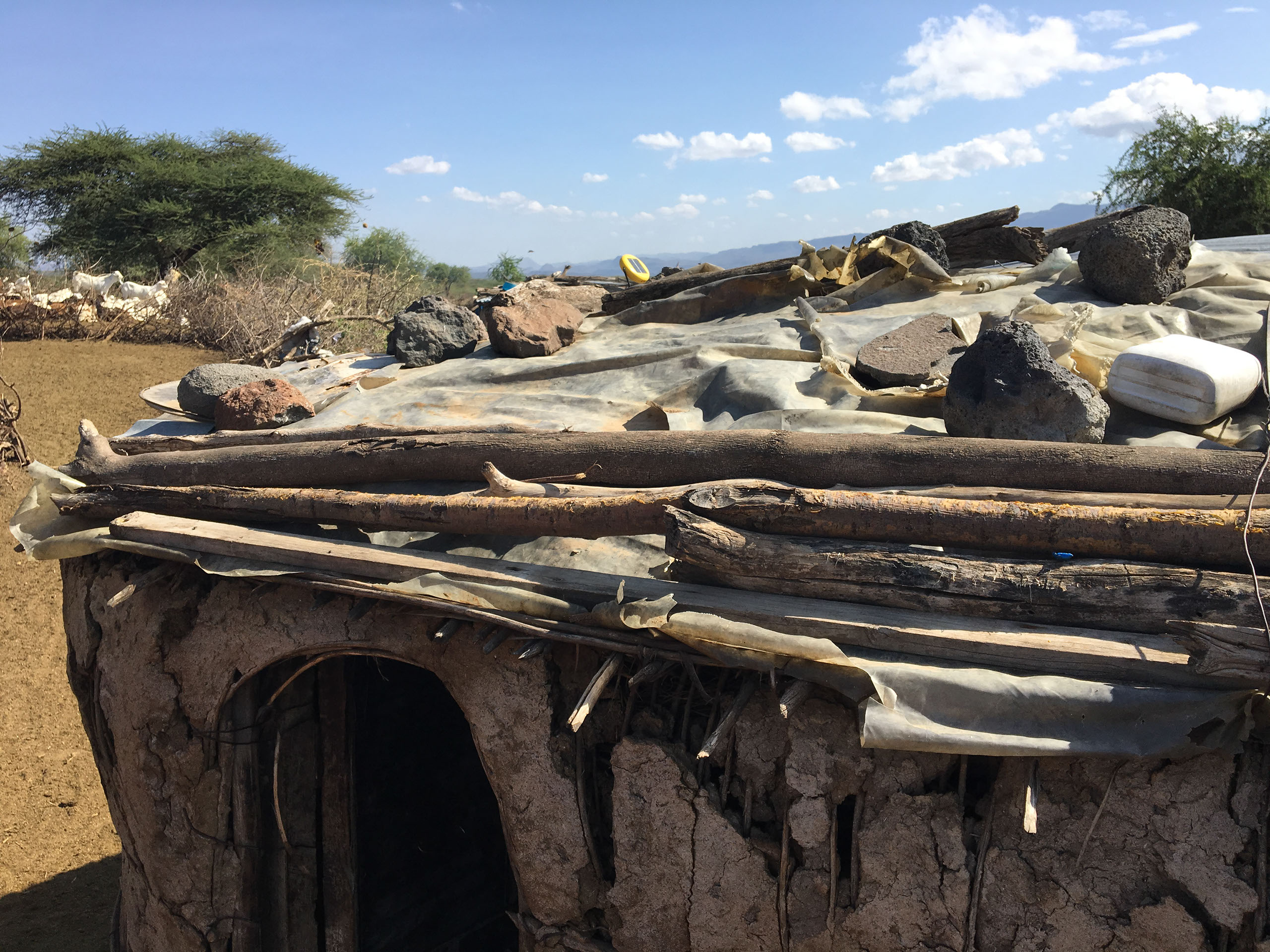
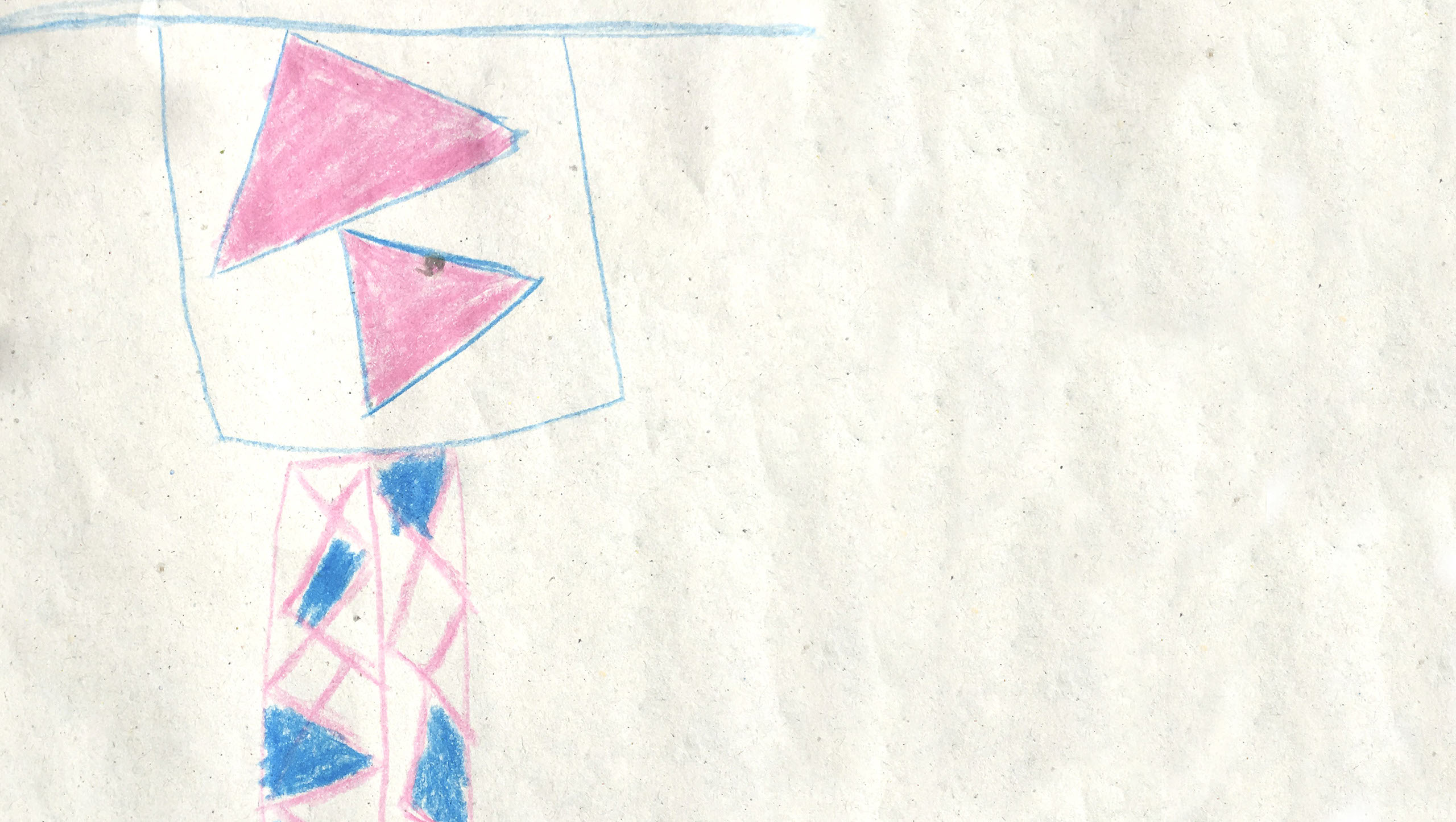
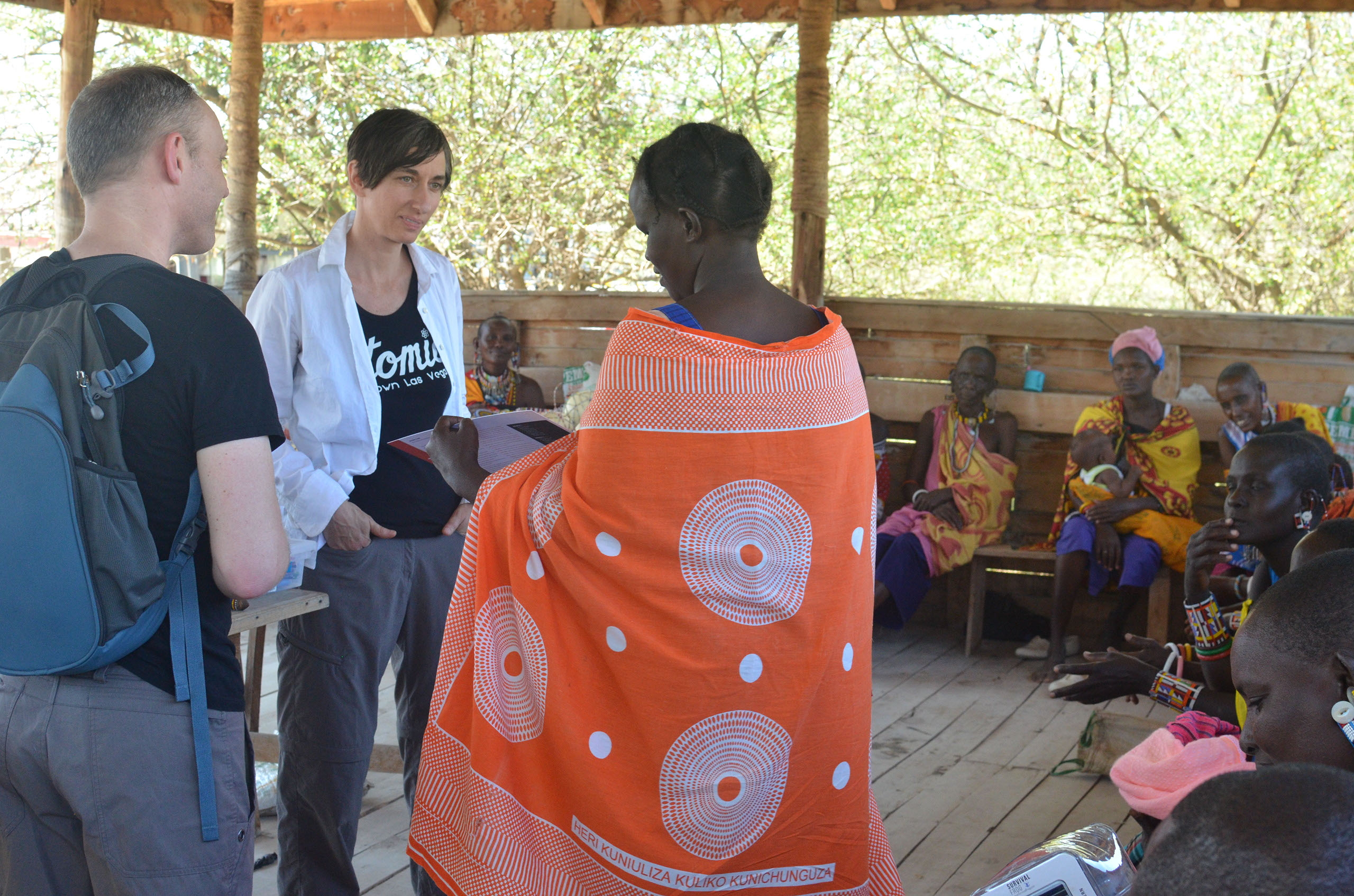

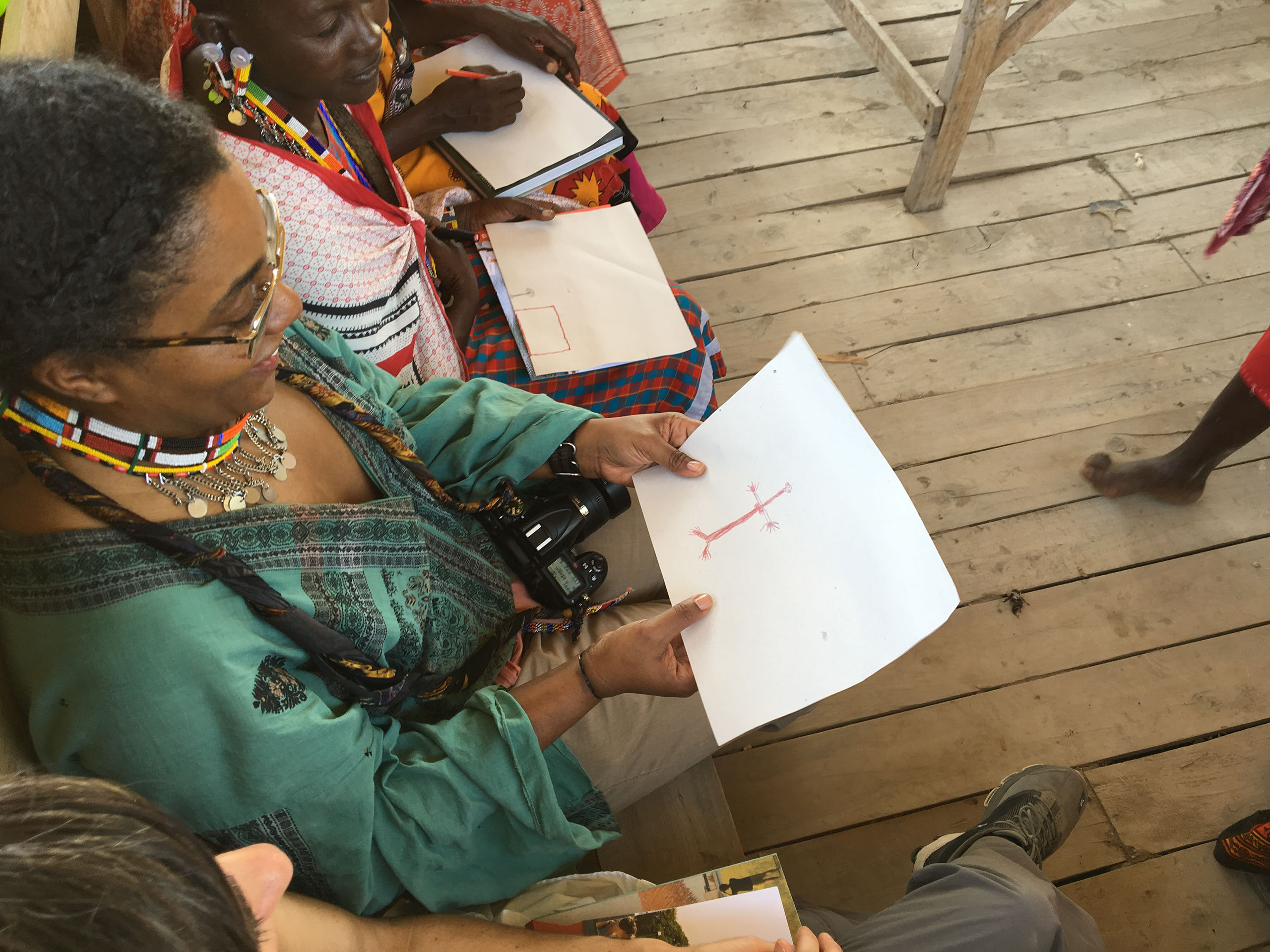
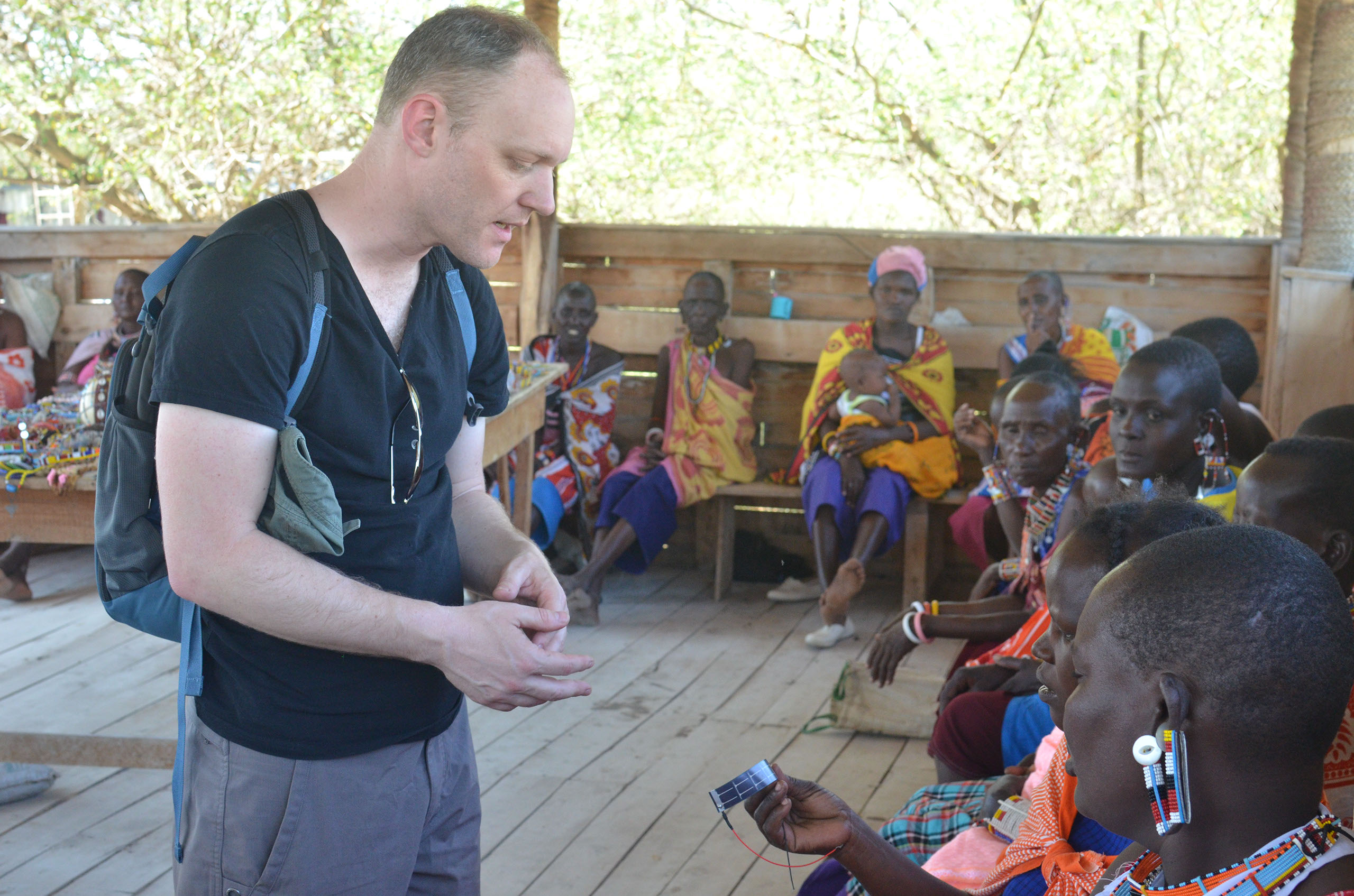

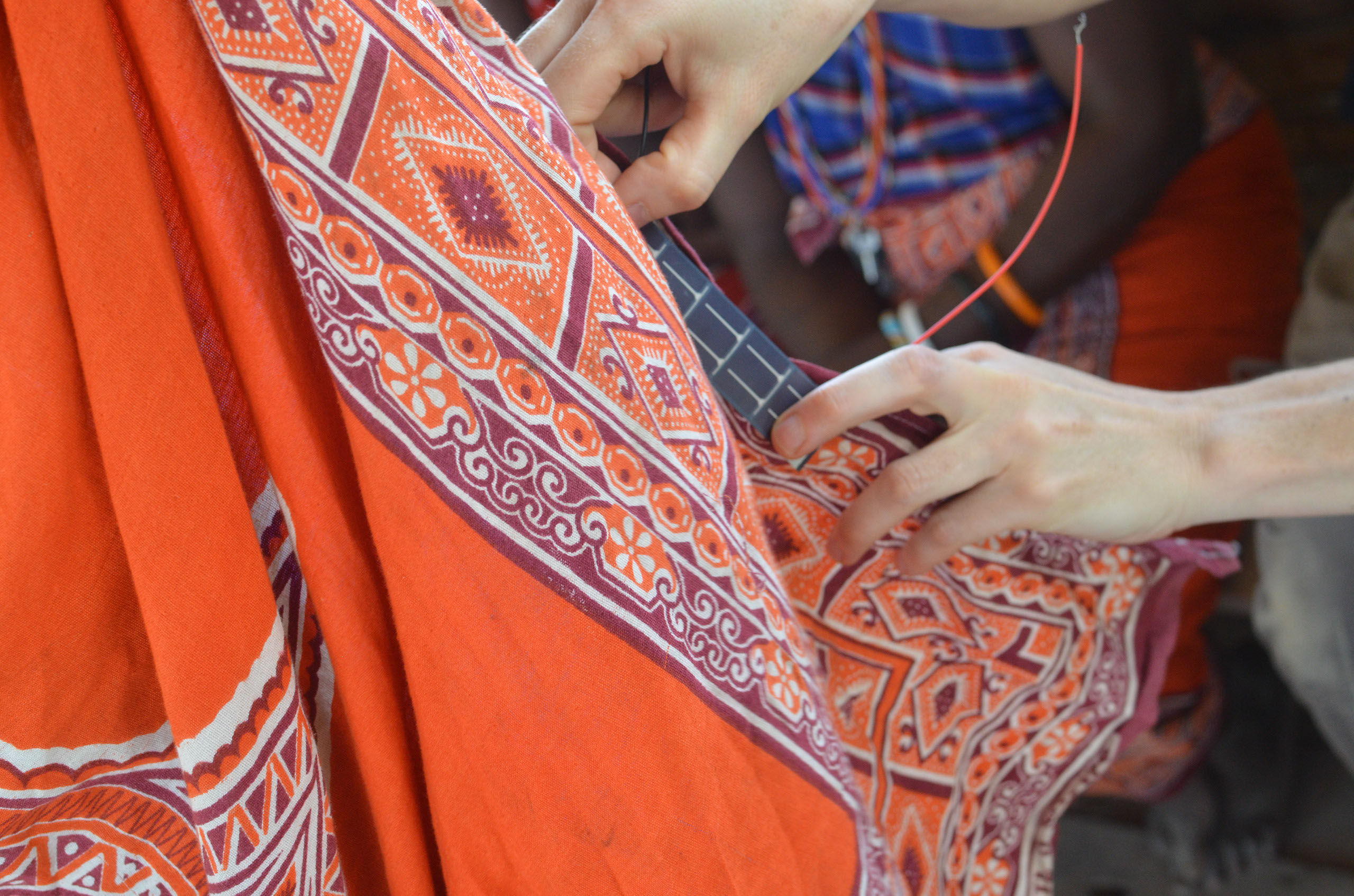
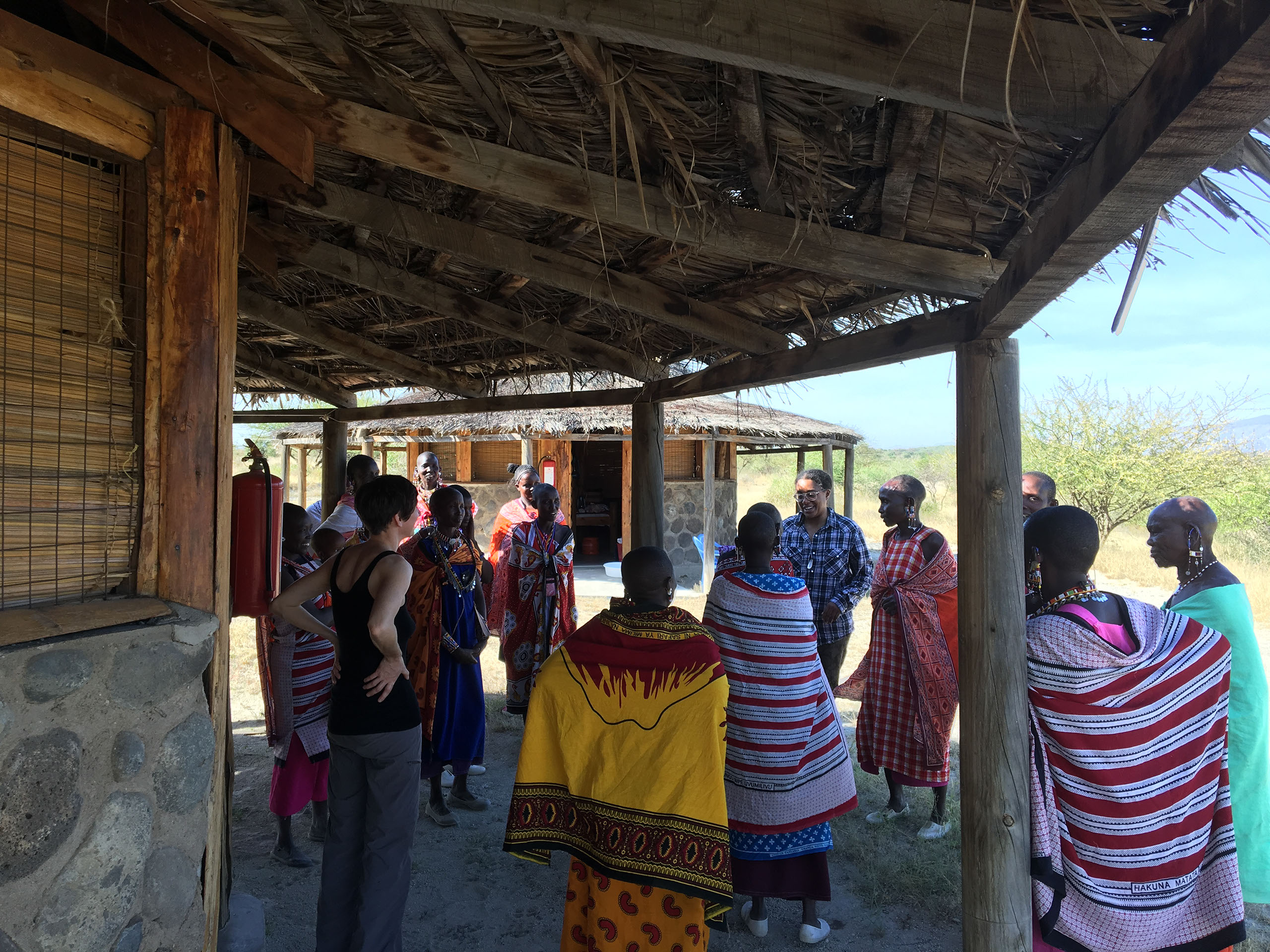
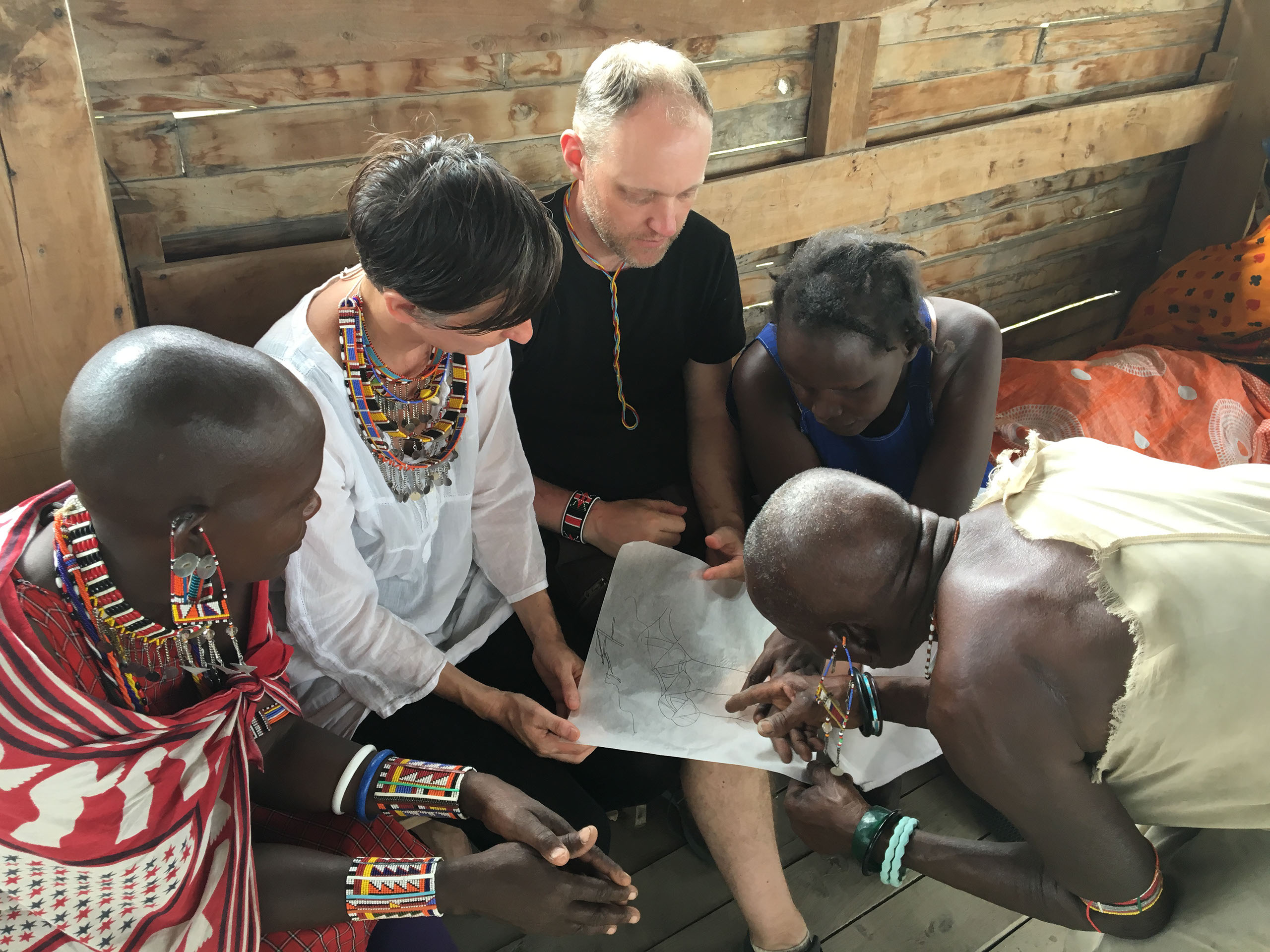
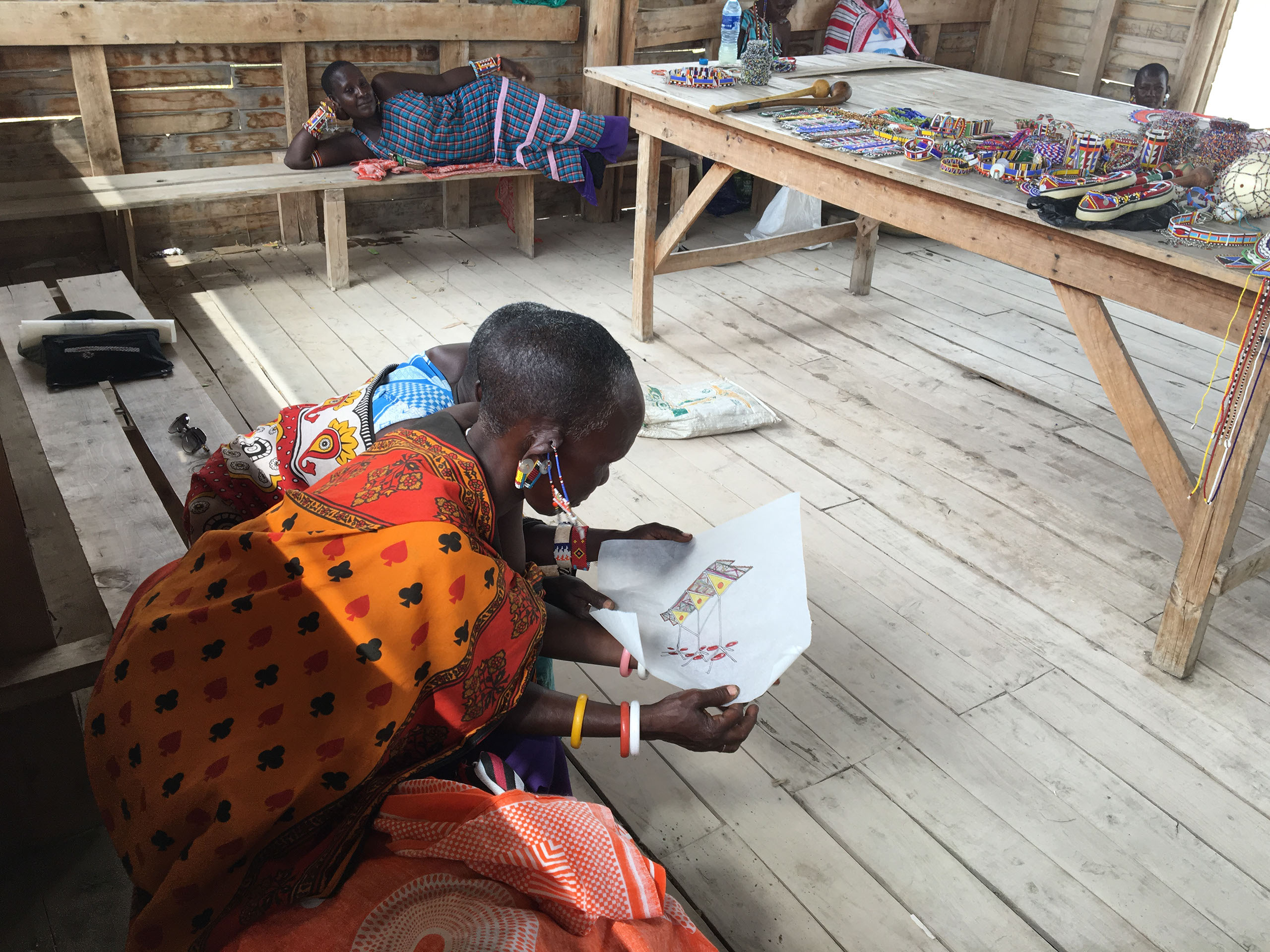


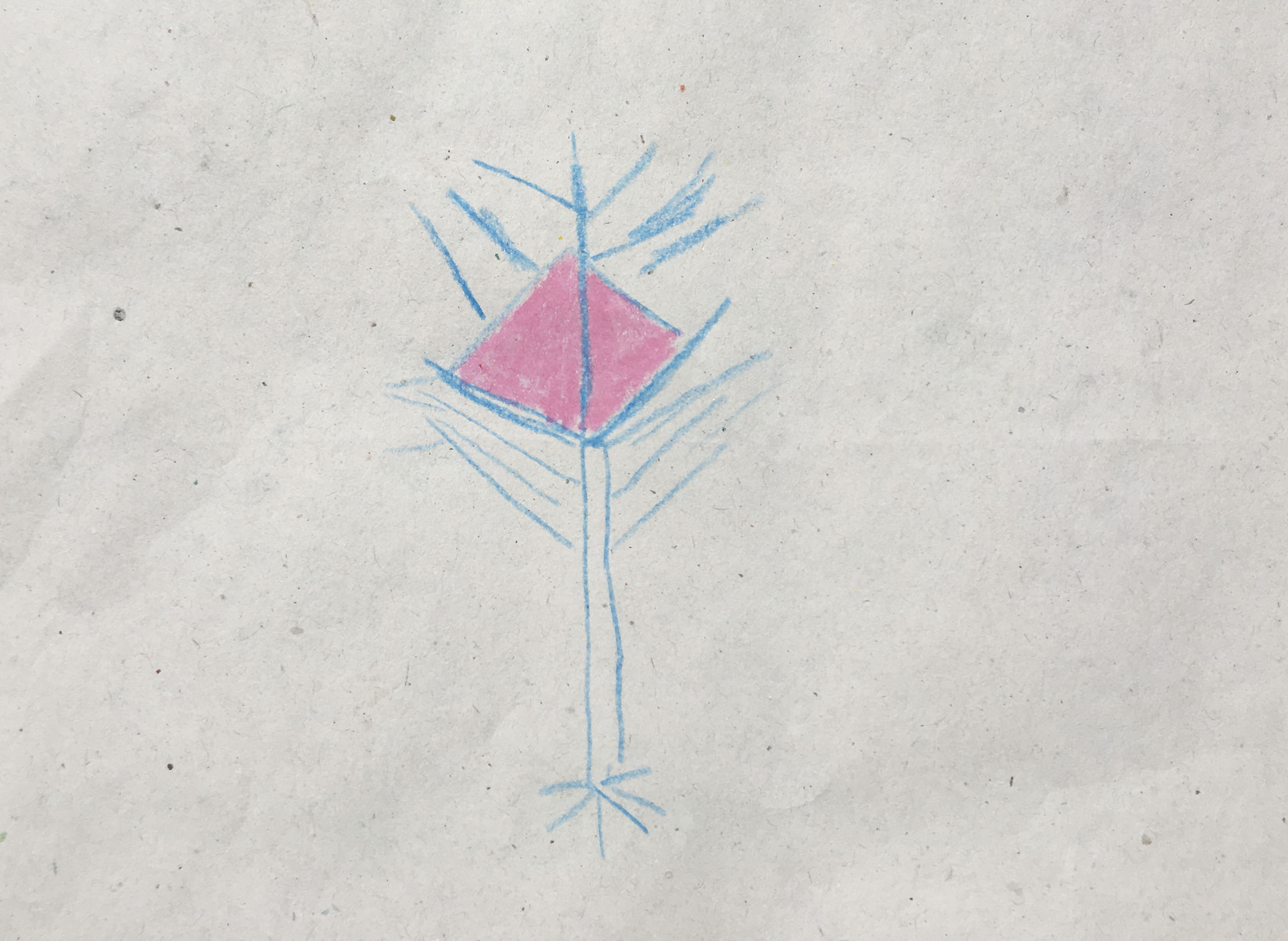

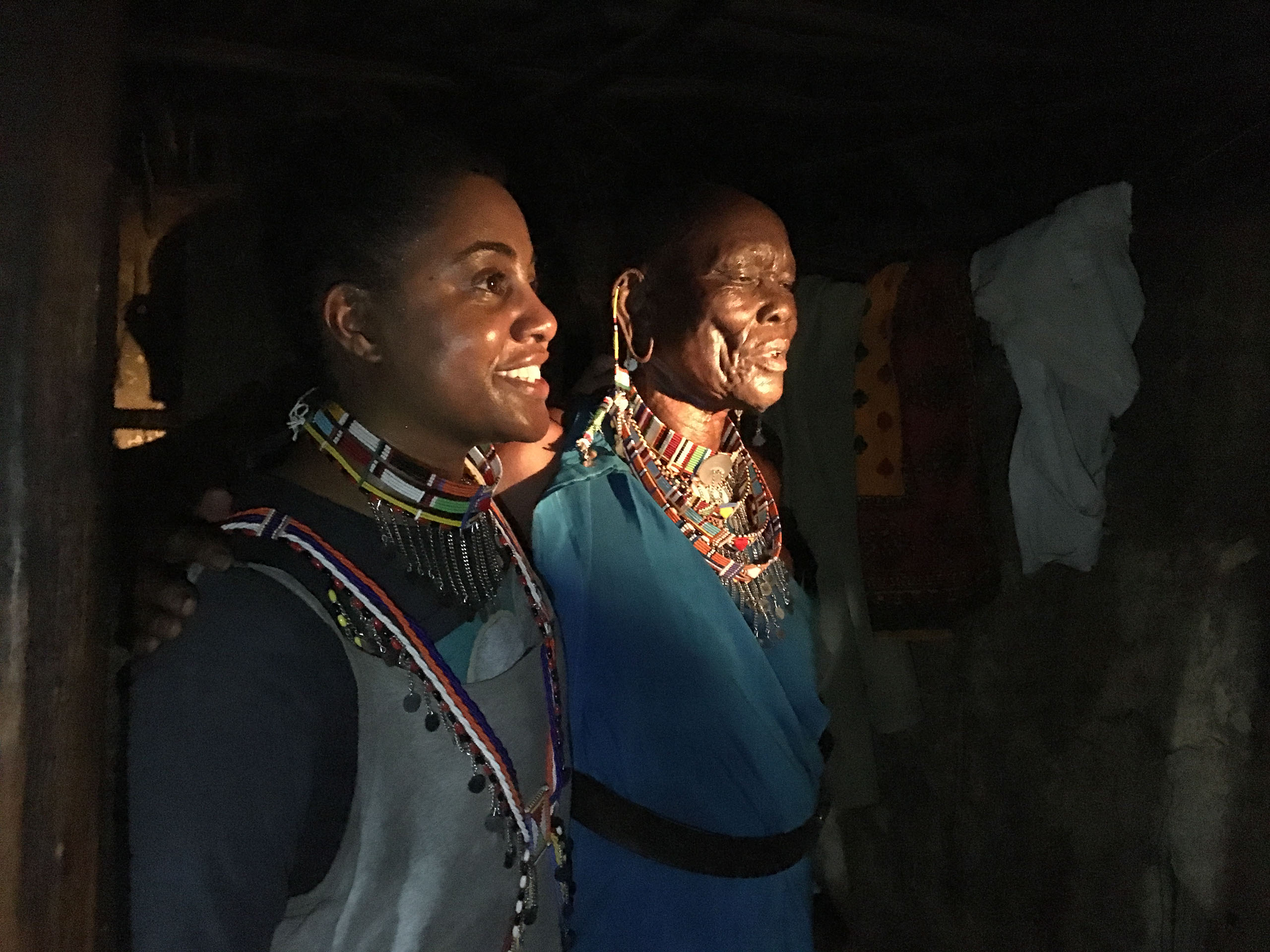
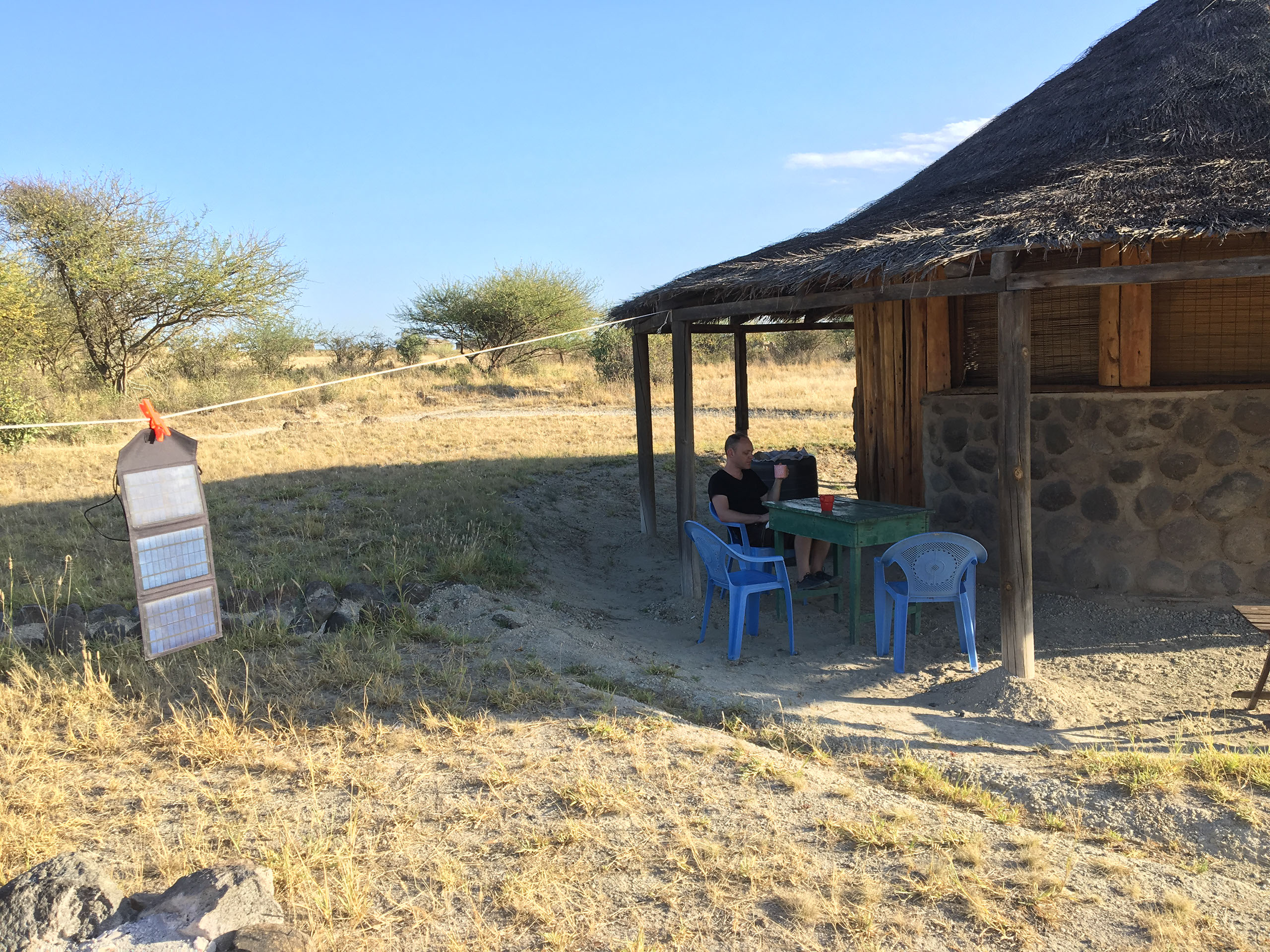
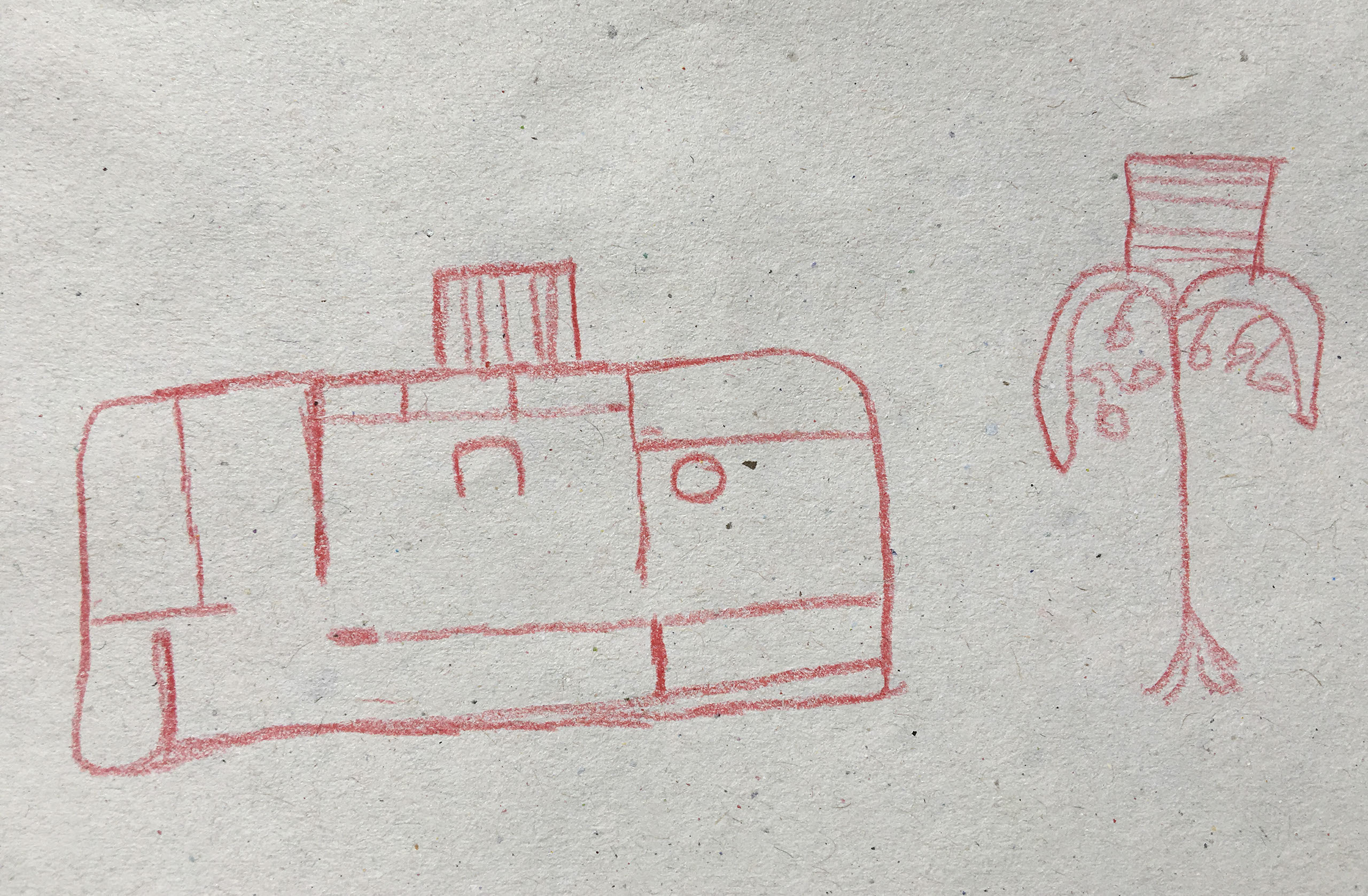
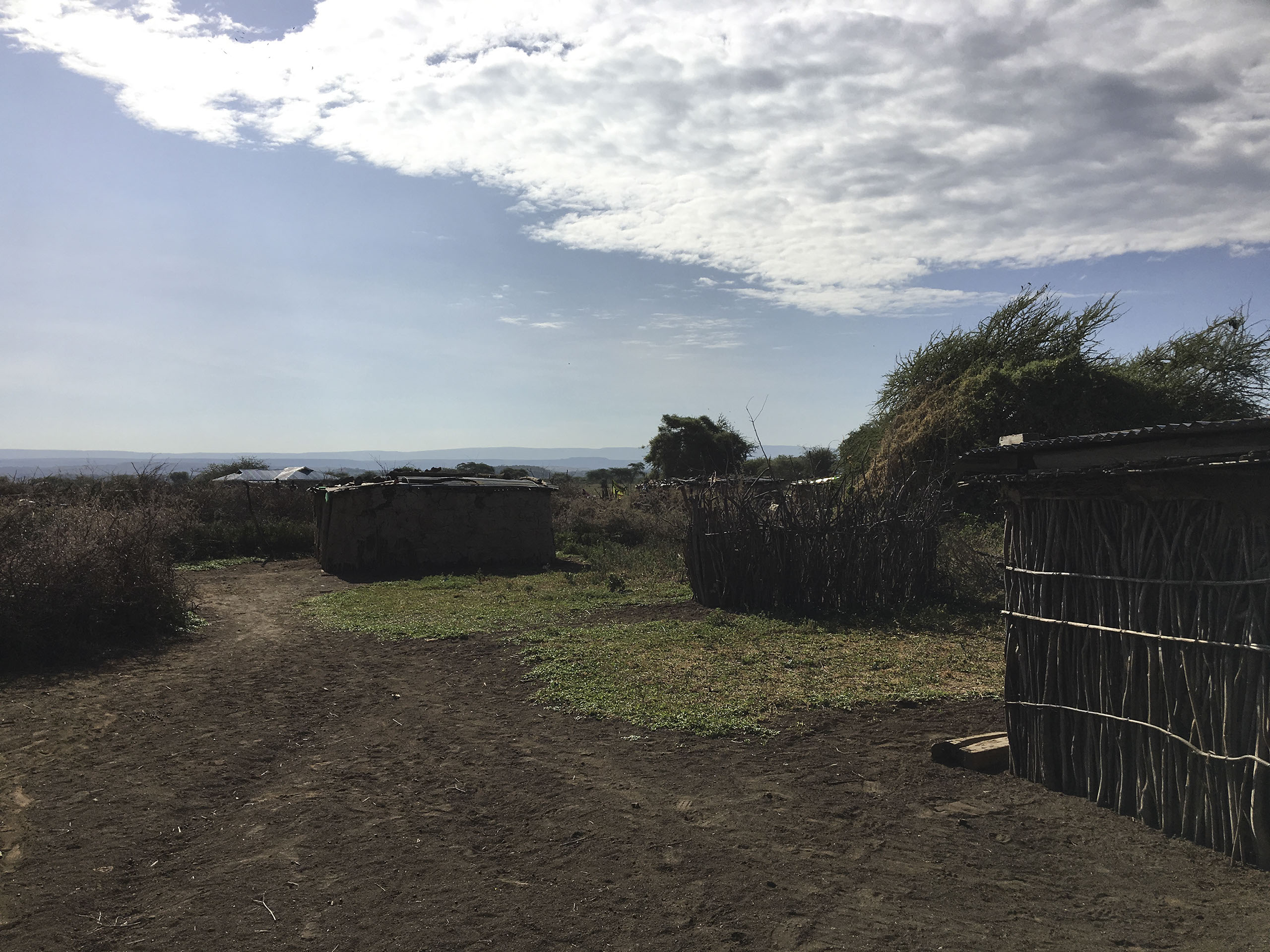
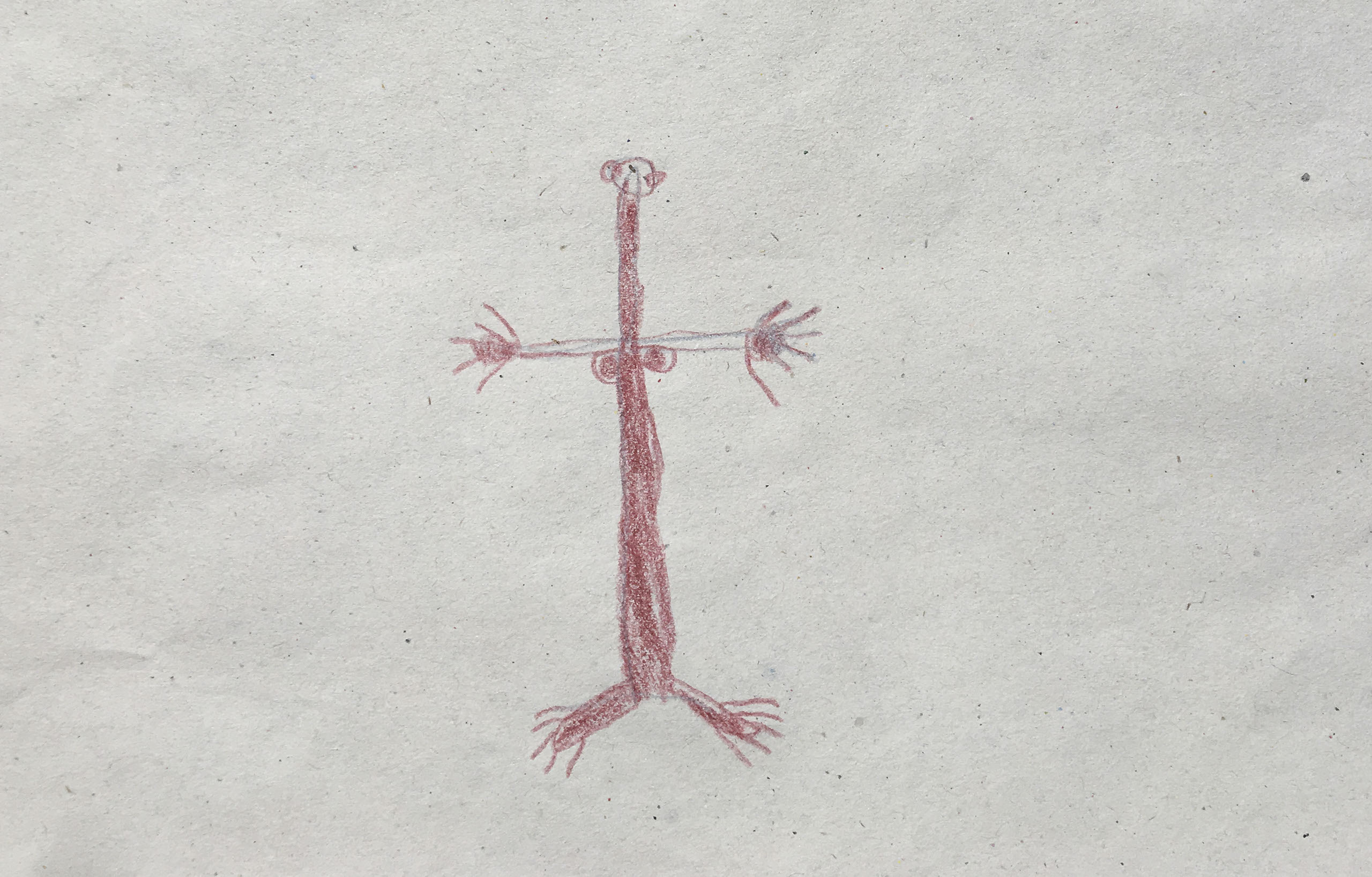



























Maasai women of Olorgesailie Kenya take the lead in designing renewable energy installations for their homesteads.
The artisans asked if it was possible to integrate the technology into the items (such as jewelery and belts) that they wear daily.
A sketching session on our first day revealed a series of forms and shapes to work with.
Regina began drawing from the sky downward, including solar planes into her composition along the way.
Elizabeth used the LAGI Art+Energy Flash Cards to help illustrate how renewable energy can be art. Photo by Tereneh Mosley.
Maasai women of Olorgesailie Kenya take the lead in designing renewable energy installations for their homesteads.
This unique and delicate eco-system must be protected from disruptive energy installations.
Maasai women of Olorgesailie Kenya take the lead in designing renewable energy installations for their homesteads. Photo by Tereneh Mosley.
This sketch by Maria M represents a homestead (boma), containing multiple homes (manyatta), with a solar artwork in the center.
The form of the solar artwork is inspired by the root and stem of the local field grass.
The tiny solar light on the roof of this manyatta represents the amount of light that some of the homes currently have access to.
It throws a little less than a flashlight. The manyatta's are nearly pitch dark during the day.
This sketch by Regina started with a horizontal line representing the sky. Below is a solar receiver and a trussed structure, the triangles of which
are similar to the triangles that are a part of traditional bracelet designs. Solar panels are inside some of the truss openings as well.
LAGI co-directors Elizabeth Monoian and Robert Ferry discuss the LAGI Art+Energy Flash Cards with Elizabeth.
Photo by Tereneh Mosley.
There are 24–30 manyatta's (houses) in a boma (homestead).
Sketches are shared with Tereneh Mosley, who has been working with the Olorgesailie Maasai Women Artisans (OMWA) since 2013.
LAGI co-director Robert Ferry shares examples of solar technology during the workshop. Photo by Tereneh Mosley.
The artisans asked if it was possible to integrate the technology into the items (such as jewelery and belts) that they wear daily.
One of our favorite ideas was the integration of solar and LED technology into fabric worn during the day, which can then be placed on
a wooden frame for outdoor lighting, or hung from the ceiling to light the interior of the banda. Photo by Tereneh Mosley
On March 14, 2016 we arrived in Olorgesailie and were greeted by the Maasai women within minutes of arriving at our bandas.
Our final workshop day included a group discussion following LAGI presentation of a Boma Solar design.
These sketches represented the third iteration of the solar structure design, which took into consideration the architecture of the manyatta,
the traditional Maasai jewelry, and the sketches that OMWA made on the first day. Photo by Tereneh Mosley
Our final workshop day included a group discussion following LAGI presentation of a Boma Solar design.
These sketches represented the third iteration of the solar structure design, which took into consideration the architecture of the manyatta,
the traditional Maasai jewelry, and the sketches that OMWA made on the first day. Photo by Tereneh Mosley
Olorgesailie is home to a prehistoric site discovered in the 1940s by a team led by Dr. Mary Leaky.
Evidence of humans activity here dates back 800,000 years.
This area is home to thousands of baboons in their natural habitat.
Regina sketched her version of a solar installation, which incorporates triangular solar panels as a wild flower with a thorny stem, similar to
those that can be found around Olorgesailie.
We came upon this tree filled with baboons on our walk back to our bandas from the homestead.
Tereneh Mosley visits the manyatta of Leah Tale, who is the oldest member of OMWA. Tale made all of the jewelery that both women are
wearing. After initial design sessions with Idia'Dega two years ago, Tale has expressed her interest in expanding her designs outside of
traditional patterns, including the development of the new design seen here in the chocker Tereneh is wearing.
You can also see from this photo how very little light there is in a home during the day. The only light here is thrown from another camera flash.
Robert Ferry enjoys his morning routine before temperatures hit 100 degrees Fahrenheit.
Lakati Elizabeth drew the floorplan of her banda with a solar sculpture remeniscent of a fruiting tree. Several women in the group imagined
shade structures designed with patterns from local trees and with ribbon-like solar "branches" that follow the sun's path across the
equatorial sky.
The Maasai women are architects and builders and all of the manyatta's are built by them. All members of the community are determining
the best locations in the homestead for the solar installations.
Letei Naomy sketched this abstraction of the human form with a strong, tree-like foundation.
There is clearly a large overlap between renewable energy projects and indigenous peoples’ territories in Kenya. As such, the renewable energy corporations have a responsibility to respect the rights of these communities in line with international and national human rights instruments. The UN Guiding Principles on Business and Human Rights place the responsibility on business enterprises to respect the rights of communities when undertaking projects on their lands and territories. Renewable energy projects in Kenya must therefore be designed and implemented in ways that protect and advance the rights of indigenous peoples.
Renewable Energy Projects and the Rights of Marginalised/Indigenous Communities in Kenya
IWGIA — Report #21, November 2015
Atasa Solar
The Land Art Generator, Idia'Dega, Olorgesailie Maasai Women Artisans (OMWA) partnership is bringing aesthetically and culturally relevant renewable energy infrastructure to the Maasai community in Olorgesailie Kenya.
The Maasai women who have been working closely with Tereneh Mosley and Idia'Dega: Elegant Ethical Apparel — A Global Eco-Design Collaboration have taken the lead in designing creative installations that have the added benefit of generating clean and renewable energy for their community.
The outcome of this participatory community design model is as much about the cultural exchange as it is about the clean energy infrastructure outcome. The goal is to provide a better infrastructure that will help to support the creative process and sustainability of the community into the future.
Rather than imposing external engineering aesthetics and the resulting cultural impact of conventional renewable energy infrastructures, the idea is to place the Maasai women in the role of lead designer, and through this agency establish a healthy relationship between renewable energy infrastructure, indigenous human rights, and cultural & aesthetic needs.
The ARTISTS
Dikka Emmy
Karaiton Maria
Karura Rebecca
Katano Alice
Kilakoi Elizabeth
Kilenoi Agnes
Kinta Regina
Kitamuas Maria
Lakati Elizabeth
Lanket Marisa
Letei Naomy
Loice Mary
Maato Joiyce
Machipei Rosemary
Mankeni Agnes
Metui Maria
Momery Hellen
Mpuyuk Esther
Mukana Jane
Naiyonte Esther
Nancy Grace
Nasitoi Esther
Nepetia Jemimah
Ntaine Charity
Ntete Peninah
Pilanoi Naomy
Rimas Mary
Rokiya Agnes
Sein Joyce
Sekento Eunice
Sencha Jane
Simpano Jackline
Siyai Ncharucha
Sunkura Agnes
Tale Leah
Tekenet Regina
The Process
We began the design workshops through discussion on solar energy (facilitated by Elizabeth Kilakoi, an Olorgesailie local who speaks both English and Maa). We talked about what scale of energy generation was possible and what the women would like to see as additions to their homesteads.
After talking about how the design ideas that they bring to the Idia'Dega design collaboration could be translated to solar designs, Regina began sketching an idea for a solar artwork. Sketching caught on like wildfire and soon all of the artisans were drawing their ideas. The sketches led to conversations about the themes and symbols that were shared amongst many of the women. Representations of the sun, trees, animals, and other geometric shapes flowed forth from the paper.
By the end of the week long workshop multiple designs were chosen to move forward to implementation. They included wearable solutions as well as more infrastructural scales for homesteads.
All designs are deeply reflective of the aesthetic and cultural needs of the women and their families.
The NEED
- Currently there is limited access to electricity, water, and sustainable heating/cooking methods.
- A lack of access to lighting at night limits in-home learning.
- The local population is experiencing increasingly difficult economic and social pressures on land and resources.
- The artisans require the ability to communicate with international partners, which means the need to charge cell phones.
- This access to communication tools increases creative and revenue building projects.
- Sustainable financial models that place the Maasai women at the table of the 21st century global economy.
The GOAL
Utilizing local materials with renewable energy technologies provided by the partnership as the sculptural media, Maasai women are designing functional art objects that reflect their culture and vision for the future.
At scales ranging between 100 Wp and 5 kWp the collective output of the sculptural design-build effort will provide sustainable electricity to power individual homes, a freshwater pump, and even wearable solar power designed to meet the needs of the Maasai culture as a part of the Idia'Dega fashion collaborative. Other potential benefits include providing a solar cooking apparatus as a part of some of the installations.
This approach to rural electrification for the Maasai is taken with a long-term vision for generating a sustainable economy for the local community. The design outcomes will not only be implemented locally and build knowledge capacity, but will also be marketed to a global audience, providing a continuous income for the Maasai designers as the prototypes installed in Olorgesailie are produced by OMWA for an expanding global market.
The story
In the winter of 2015, we were contacted by Tereneh Mosley, the founder of Idia’Dega, who has been working since 2013 with Maasai Women Artisans in Olorgesailie—a remote location in South Rift Valley of Kenya where Maasai are starting to feel the pressures on land use from the outside world. One of those pressures is renewable energy infrastructure for the national grid. With excellent insolation, the land around Oloresailie is already being tapped for solar energy projects, but none of the new energy infrastructure is being planned to serve the modest needs of the local community. Rather it is being installed to serve the national grid for use in cities like Nairobi.
The work of Idia’Dega in sustainable fashion has shown that it is possible to design new products collaboratively with the Olorgesailie Maasai Women Artisans (OMWA) and other indigenous groups through processes that elevate local communities and empower them to create their own economic future on the global stage. Through her conversations with OMWA, Tereneh learned that modest electrification is something that is a pressing need — contributing to security, education, communication and creative /revenue building projects. Nearly everyone goes without light after sunset and the only way to charge cellphones is to walk an hour or more in each direction and pay someone in the nearest grid-tied village.
Building on the strong relationships and design model that Tereneh has established, Idia’Dega and Land Art Generator embarked on a collaboration with OMWA to design culturally and aesthetically relevant solar infrastructure for off-grid Maasai homesteads.
